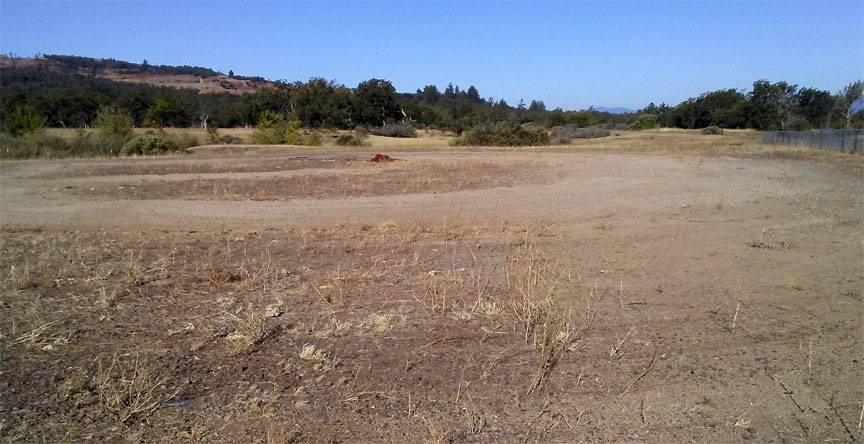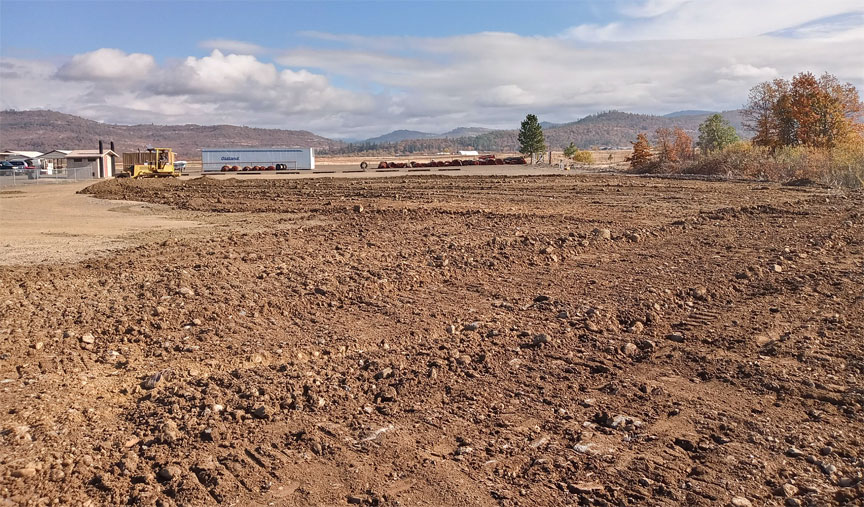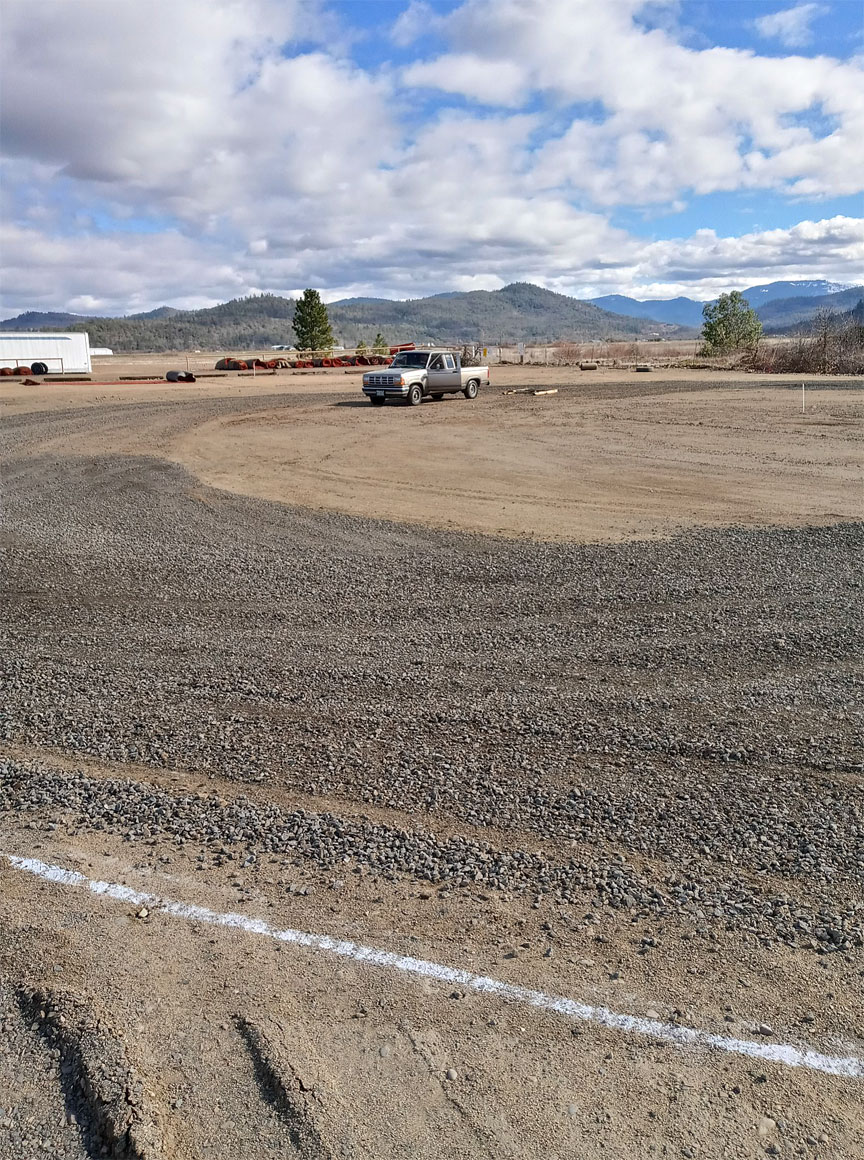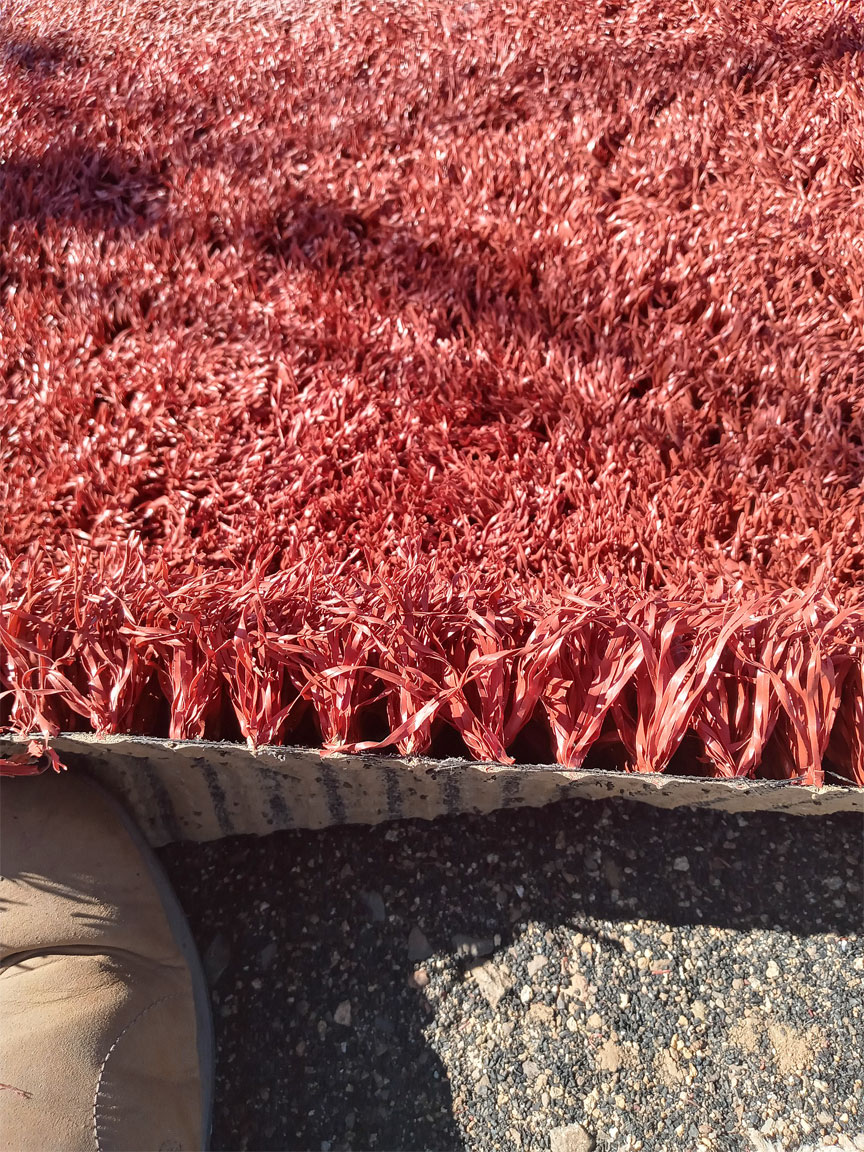The control-line circle at the Rogue Eagles RC club's flying site in Eagle Point, Ore., with luxury pit area at right of circle. All photos by Jess Walls.
Control-line field construction
Medford area fliers create a smooth circle for all kinds of CL flying
By Jess Walls
While my wife and I were considering a move to Medford, Ore., I was checking out the flying sites in the area. The Rogue Eagles radio control club (130 members) had a paved runway, shade structure, bathrooms, open space, few neighbors, county-controlled parkland and great weather! We also had some relatives in the area, so we moved and I got involved with club activities.
The club puts on an airshow in August with the proceeds going to charity. One of the acts in the airshow was Roger Hebner flying a control-line stunt plane. He needed a helper to launch him and, since I had flown CL more recently than anyone else, I was chosen. Roger lamented about how few CL circles were available in the Medford area.
Some time later I spotted three guys flying CL in the county fairgrounds parking lot. I stopped and introduced myself and we had a great time talking airplanes. There was interest but no really good flying sites. They could only fly when the lot was empty, which wasn’t very often. These guys were not Rogue Eagles members and had no interest in R/C flying.
At a club meeting I shared information about the Ringmaster Fly-A-Thon and there was some interest. The Rogue Eagles field had plenty of room but a lot of it was rocky and full of weeds. It would have been difficult to accommodate CL and RC on the same day because we would have to share the runway. So the Fly-A-Thon happened at one of the county's Little League fields that year.
We had a dozen or more club members participate (with much laughter and falling over dizzy – throttle solves the dizzy part) and at a later club meeting there was a motion made to lay out a CL circle in the rough parking lot that was used for the airshow. Road base rock and decomposed granite were spread and compacted and we had a circle! It was not flat, and some landings were more roller coaster than taxi but it was flyable if you weren’t too fussy about rock damage. The guys at the
fairgrounds came to look but didn’t want to risk their competition stunt models on such a rough and uneven surface. My Flite Streak and Ringmasters suffered damage so I understood their concerns. DG is kind of like 80-grit sandpaper. Not an issue if you have big wheels and land smoothly. Combat models would suffer greatly.
Not long after the circle was complete, Medford City Parks and Recreation began renovation of one of their baseball field infields. It was suggested that the “Field Turf” material might make a good circle surface and a belly landing strip for R/C planes without wheels. The club officers and I went to check out the material and it looked pretty good to me. Not everybody was convinced. But I got permission to talk with the city about acquiring the material and found out that there would be no cost since the material otherwise had to be hauled 250 miles to be disposed of. Eight miles to our field would be way cheaper!
Oops. Lawyers. Yes, liability concerns.
The City didn’t want to risk being liable for injuries since they were removing the turf because it posed an injury risk to the athletes. It took a few letters and conversations before they understood that we wanted to use the turf as a runway, not an athletic surface of any kind. Walking to retrieve a plane only. The City lawyers finally agreed and we were on our way!
We needed to rent a large forklift to unload the flatbed truck that was hauling the 2,000-pound rolls of cut turf. We unloaded 3 truckloads and the club officers said “that’s enough!” The rolls we got did take up about 1,000 square feet of space and our plans for using the turf were not fully developed. Did we have enough? Too much? How would we dispose of the excess?
So the RC belly landing strip ended up being installed first. A helicopter hover practice pad was built next (rarely used). What turf was left was not enough to cover the whole circle.
Field Turf is like a heavy duty “Astroturf” carpet. The nap is about 1-¼ inch long and the rolls are 12 feet wide. The turf is unrolled and the seams are sealed with hot melt glue just like wall-to-wall home carpet. After the turf is laid out a mixture of sand and ground rubber (recycled auto tires) is spread out and swept into the nap until the desired texture is achieved. More rubber makes for a softer surface for football and similar physically rough sports; more sand provides a harder surface for
baseball or soccer type events. That requires a lot of sand and rubber! That equals HEAVY!
We did not use seam sealer strips. We just laid the turf down and the weight of the sand held it in place. When the crews were removing the old turf they cut it into 7’ wide strips and rolled it up with the backing on the outside. If I were to do this again I would mark each roll and create a map so we could unroll each roll in exactly the same location relative to the next roll. That way all the edges would match. The City renewed a soccer field recently and that would have been the best. Solid color, minimal cutting, the entire area could have been covered (soccer fields are 300’ x 400’ or so). The sand and rubber provide cushioning and are necessary to keep the turf from blowing away during a windstorm, to keep the edges from coming up and to provide UV protection to the backing.
Some of our turf sat rolled up and unused for the three years the project finally took to complete. During that time the backing deteriorated so badly that we ended up taking several rolls worth to the dump because it was shredded due to UV degradation. The three-year delay was due to wanting to have a flat circle. The control-line circle is also the airshow parking lot and it needed to be graded.
Several governmental agencies needed to give permission. Some were concerned with possible cultural artifacts (none present after a study was done), others with endangered species (none present after a study was done), modelers may be endangered (but no study was required). The studies were done for free but the grading wasn’t. The grading was the biggest expense and also the source of much frustration. Long story short, the grading was OK but could have been much better. The top surface (turf) reflects what is underneath. We should have done more to get a really good, flat, smooth base. Road base is perfect material, DG is not needed.
The parking area where we have the circle and pits is about 170’ x 250’. Our circle ended up with a 72’ radius outer edge and a 58’ inner radius. We cut pie-shaped wedges out of the turf and dragged them into position by hand. Hard work, very physical, very heavy, very slow going. Cutting the turf was a tricky problem. If we cut from the top down through the sand, that was very difficult. If we cut the back side, that was easy but all the sand and rubber fell out! We worked out a system where we flipped the turf upside down, cut the wedges and flipped them back upright with a minimum of disturbance and so retained most of the sand and rubber.
Just moving the 1-ton rolls of turf took a lot of planning. We rented a skid steer (bobcat) with forks and could just barely lift one roll (if it wasn’t wet!). We would move the roll into position as accurately as possible, then drive the skid steer to the other side and lift and push (carefully!) to unroll each roll. We tore holes occasionally but the turf tends to lay flat and once in place we just add a little extra sand and rubber and the tears are invisible.
The fairgrounds group joined the club, and did the majority of the turf installation. They now fully endorse the turf and happily fly even their 20-point Precision Aerobatics planes here now. And they can fly any day of the week! Any week of the year! Except for the two days of the club airshow.
Many thanks are due to the amazing group of club volunteers who worked so hard, and long, to make this circle a reality! There are too few modelers these days to have separate RC and CL groups. Most RC fields could have a control line circle somewhere on their grounds. Join forces! Make friends!
Before the turf was installed, no one would fly gliders or hand launched airplanes because the asphalt runway, or rocks along side the runway, would cause too much damage. We now have hand launched pylon racers and gliders regularly being flown and landed on the turf!
The turf has worked so well that some people want to add turf to the perimeter of the paved runway! Landing short, long, or wide means potentially encountering airplane-munching rocks.
Our surface’s texture is half way between a golf course putting green and a fairway. We probably have more ground up rubber than we need; it can be a messy nuisance. We are still learning what percentages work best. Excess rubber can be removed with a broom or leaf blower if needed.
As far as control line goes, the turf is easy on Combat planes, can be taxied on easily, is MUCH easier on a plane that crashes than asphalt and requires minimal maintenance. We sweep it occasionally to get rid of leaves and animal droppings, but do not mow ever! In comparison, the $40,000 club asphalt runway (which I also enjoy using for RC) has required over $10,000 worth of crack filling and resealing in the past 15 years.
Flying site development in photos

Before the surfacing project: A rough circle graded oiut of a parking lot.

Start of grading.

One-ton rolls of turf taken from a city baseball field.

A small tractor spreads out donated rock.

A pickup truck tows a finishing grader to smooth out the gravel.

Laying out the turf. It took a forklift to move the heavy rolls.

Cross-section view of the turf.

The turf when new.

After application of sand and rubber.

The field in use during the 2022 Ringmaster Fly-a-Thon.
Flying Lines home page
This page was upated Jan. 5, 2023

